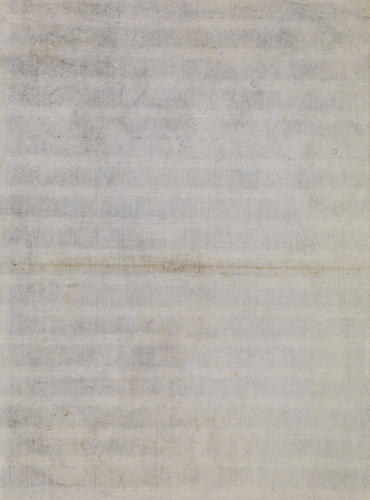A composition study for The Burial and Reception into Heaven of St Petronilla c. 1621-3
Black chalk with extensive stumping | 51.6 x 37.8 cm (sheet of paper) | RCIN 902756
-
In 1621 Guercino's Bolognese patron Cardinal Alessandro Ludovisi was elected Pope Gregory XV, and Guercino followed him to Rome. The Pope commissioned from Guercino a huge altarpiece, to be placed over the remains of St Petronilla in St Peter's. The young artist must have been required to prepare this model drawing for the approval of his patron; approval was evidently not forthcoming, for the altarpiece as painted is very different in its composition.
This drawing is a study for the most important work of Guercino's two years in Rome under the patronage of Gregory XV, the altarpiece of the Burial and Reception into Heaven of St Petronilla for St Peter's, Rome. Nothing is known of the historical details of St Petronilla, who died around AD 100, but a legend grew that she was a daughter of St Peter, and was betrothed to a pagan nobleman called Flaccus. Unwilling to enter the marriage, Petronilla took to fasting and prayer and soon died. Her tomb in the catacomb of Domitilla was venerated from an early date, and in the fourth century a basilica was erected on the site to house her remains and those of Sts Nereus and Achilleus. In the eighth century she was named protectress of the Frankish kings, and her sarcophagus was transferred to St Peter's. After the rebuilding of St Peter's in the sixteenth century her remains were placed, in 1606, in an altar to the right of the tribune of the basilica. Guercino received the commission to paint the altarpiece - the only one for St Peter's to be commissioned by Gregory XV - in December 1621, and delivered the work in May 1623, shortly before the Pope's death. In 1730 Guercino's painting was replaced with a mosaic copy, by Pietro Paolo Cristofari. The painting is now in the Capitoline picture gallery.
The unusual subject of the burial of the saint must have been chosen because no dramatic episodes of her life were known; but placed over the altar that housed her earthly remains, the painting would have given the theatrical effect of watching the saint's body being lowered down to her final resting place. The problem for Guercino was that this inevitably concentrated attention at the bottom of the enormous canvas, over 7m (24 ft) high, and he had to devise a composition that adequately filled the pictorial field.
In Guercino's early compositional drawings he experimented with different moments of the burial. Studies in the Courtauld Institute and in the Royal Collection show only a lamentation over the body of the saint, while another sketch at Windsor shows her body being lifted from its bier. In the present study the saint's body is being moved towards the open grave; what appears to be a cross at centre left is the bier being carried away from the scene. The richly dressed young man on a horse has been plausibly identified as Flaccus, the bearded labourer who points to the saint implausibly as St Peter. The background architecture shows that Guercino was aware of the need to articulate the picture surface with massive elements, though the space implied by the receding wall at centre left is poorly defined and the figures are seen from inconsistent angles, a consequence of combining several separate studies in this one sheet.
Given the great importance of the site, it is very likely that the young artist was required to prepare a modello for the examination of his patrons. Indeed, this is the only extant large modello for a painting by Guercino, and he attempted to capture something of the effect of the intended painting by rubbing the black chalk to model the figures. But whether it was the Pope (or his proxy) or the artist who was dissatisfied with this composition, it was to be wholly reworked, and only Christ resembles the equivalent figure in the painting.
A subsequent drawing in Copenhagen shows the saint being lowered into the grave, and attempts to solve the spatial confusion by organising the figures into receding planes. But the great height of the altarpiece would remain a problem: although the figures here and in the Copenhagen study would be roughly life-size if scaled up to the canvas, there would remain large areas of dead space at the centre of the painting. Guercino therefore radically enlarged the foreground figures in the painting, further clarifying the spatial structure. The rigorous approach to pictorial space in the painting has been seen as crucial to the development of Guercino's increasingly classicising style in the 1620s.
Catalogue entry adapted from The Art of Italy in the Royal Collection: Renaissance and Baroque, London, 2007Provenance
Bequeathed by the artist to Benedetto and Cesare Gennari; from whose descendants purchased by Richard Dalton for George III, c.1758-63; first recorded in a Royal Collection inventory of c.1800-1820 (Inv.A, p.65: 'A Capital large Drawing, being the first thought for the Picture of the finding of the Body of Sta Petronilla. NB : The Composition is much varied in the Picture, which is in the Popes Pallace of Monte Cavallo, and copy'd in Mosaic at St Peters & engrav'd both (by) Dorigny & Giacmo Freij')
-
Medium and techniques
Black chalk with extensive stumping
Measurements
51.6 x 37.8 cm (sheet of paper)
Object type(s)
Other number(s)
RL 2756










